Book contents
- Frontmatter
- Contents
- Preface
- List of contributors
- Part I Introduction
- Part II Specific tumors during pregnancy
- 8 Maternal and fetal outcome following breast cancer in pregnancy
- 9 Maternal and fetal outcome following Hodgkin's disease in pregnancy
- 10 Non-Hodgkin's lymphoma and pregnancy
- 11 Maternal and fetal outcome following invasive cervical cancer in pregnancy
- 12 Pregnancy and ovarian cancer
- 13 Malignant melanoma and pregnancy
- 14 Leukemia during pregnancy
- 15 Thyroid cancer and pregnancy
- Part III Fetal effects of cancer and its treatment
- Index
14 - Leukemia during pregnancy
from Part II - Specific tumors during pregnancy
Published online by Cambridge University Press: 06 July 2010
- Frontmatter
- Contents
- Preface
- List of contributors
- Part I Introduction
- Part II Specific tumors during pregnancy
- 8 Maternal and fetal outcome following breast cancer in pregnancy
- 9 Maternal and fetal outcome following Hodgkin's disease in pregnancy
- 10 Non-Hodgkin's lymphoma and pregnancy
- 11 Maternal and fetal outcome following invasive cervical cancer in pregnancy
- 12 Pregnancy and ovarian cancer
- 13 Malignant melanoma and pregnancy
- 14 Leukemia during pregnancy
- 15 Thyroid cancer and pregnancy
- Part III Fetal effects of cancer and its treatment
- Index
Summary
The information regarding leukemia complicating pregnancy is very limited. Since there is no systematic registration of leukemia in pregnancy, the existing knowledge is based mainly on retrospective analyses or case reports. These reports tend to describe unusual or successful cases. Thus, review articles of the published experience may have perpetuated a reporting bias. Leukemia occurring during pregnancy is very rare with an estimated incidence of one per 100000 pregnancies annually. This figure is about 3.5 times lower than the incidence of leukemia in the general population in the Western world. This lower incidence may be explained by the fact that most acute lymphatic leukemias occur in childhood, while most acute myeloid leukemias occur in late adulthood, thus relatively sparing the child-bearing years. Chronic myeloid leukemia is the main chronic leukemia during pregnancy, since chronic lymphocytic leukemia is founded mainly in the elderly.
It had been estimated that, during pregnancy, acute leukemias are more frequent than chronic and that myeloid leukemias are detected twice as often as lymphatic leukemias. The appearance of leukemia during the first trimester of pregnancy is least common, and may be explained by the use of therapeutic abortion in patients diagnosed in this trimester.
The survival of pregnant and nonpregnant leukemic women has improved with the availability of modern chemotherapy and supportive care. Remission rates of 70–75% and median survival time of 6–12 months are currently reported for pregnant women. These figures are not different from those achieved in young nonpregnant women with acute leukemia.
- Type
- Chapter
- Information
- Cancer in PregnancyMaternal and Fetal Risks, pp. 143 - 146Publisher: Cambridge University PressPrint publication year: 1996

